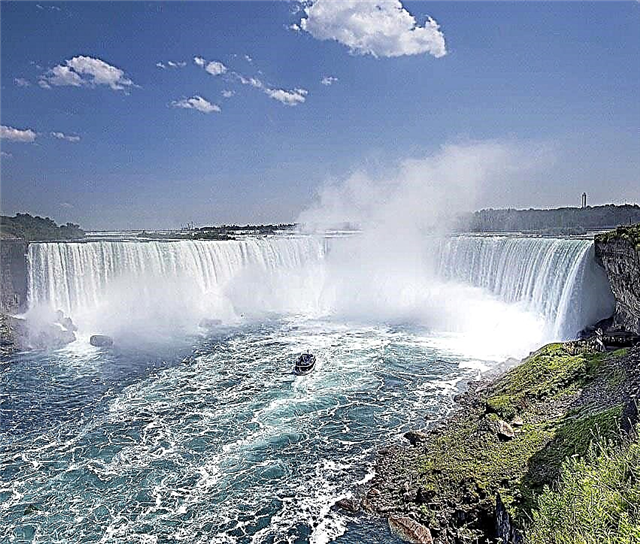One of the "Seven Summits" of the world and Europe, the birthplace of Russian mountaineering is Mount Elbrus - Mecca for skiers, freeriders, athletes storming the slopes. With proper physical training and appropriate equipment, the mountain giant obeys almost everyone. It fills the rivers of the North Caucasus with life-giving melt water.
Location of Mount Elbrus
In the area where the border of the Karachay-Cherkess and Kabardino-Balkarian republics is located, the "mountain of a thousand mountains" rises. This is how Elbrus is called in the Karachai-Balkarian language. Geographic coordinates of the area:
- latitude and longitude: 43 ° 20'45 ″ N sh., 42 ° 26'55 ″ in. etc .;
- The Western and Eastern peaks reach 5642 and 5621 m above sea level.

The peaks are located at a distance of three kilometers from each other. Below between them, at an altitude of 5416 m, the saddle runs, from where the final section of the ascent is overcome.
Characteristics of natural conditions
The age of the formed giant is more than 1 million years. It used to be an erupting volcano. His condition is currently unknown. Mineral water springs heated to +60 ° C, gushing from the rocks, testify to a temporarily dormant volcano. The last eruption was in 50 AD. e.
The mountain is characterized by a harsh climate. In winter, temperatures range from -10 ° C at the bottom to -25 ° C at around 2500 m, at the tops to -40 ° C. Heavy snowfalls are not uncommon on Elbrus.
In summer, below an altitude of 2500 m, the air heats up to +10 ° C. At 4200 m, July temperatures are below 0 ° C. The weather here is unstable: often a sunny quiet day is suddenly replaced by bad weather with snow and wind. The highest mountain in Russia shines dazzlingly on sunny days. In bad weather, it is shrouded in a gloomy fog of ragged clouds.
The mountainous relief of the Elbrus region - gorges, stone deposits, glacial streams, cascades of waterfalls. After a mark of 3500 m on Mount Elbrus, glacial kars with lakes, slopes with dangerous moraine, and many moving stones are observed. The total area of glacial formations is 145 km².
At 5500 m, the atmospheric pressure is 380 mm Hg, half that on earth.
Briefly about the history of conquest
The first Russian scientific expedition to Elbrus was organized in 1829. The participants did not reach the summit, it was conquered only by the guide. 45 years later, a group of Englishmen with the help of a guide climbed the western peak of the highest mountain in Europe. The topographic map of the area was first developed by the Russian military researcher Pastukhov, who ascended both peaks unaccompanied. During the years of Soviet power, the country developed sports mountaineering, the conquest of the peaks of the Caucasus was a matter of prestige.
The snowy, cold Elbrus Mountain does not scare away enthusiasts. They spend their holidays not on crowded beaches, but on their way to a deserted peak in order to become stronger and more enduring. There is a well-known story about the Balkarian Akhiy Sattaev, who made 9 ascents to the peaks, the last time at the age of 121.
Infrastructure, skiing
The complex of amenities and services is adequately developed only on the southern slope of Elbrus, where there are 12 km of cable cars, hotels, landing sites for helicopters. The routes on the south side are minimally fenced, almost do not impede free movement. There are lifts on busy roads. The total length of the slopes is 35 km. There are tracks for both experienced athletes and beginners.
There is a ski school and sports equipment rental. Climbing the slopes by snow groomers (alpine taxis) is organized. Freeriders are lowered by helicopter onto the virgin slopes, from where they rush down with great speed.
The skiing season begins in mid-November and lasts until April. Sometimes the snow lies densely on the slopes of the highest mountain Elbrus until May. Selected areas are available for skiers all year round. Dombay (1600–3050 m) is the most attractive and prestigious Russian ski resort. Most skiers prefer the slopes of Cheget, which rival European ski slopes. From the observation deck, tourists enjoy the views of the surrounding nature, relax in the cult cafe "Ay", where the bard Y. Vizbor often visited.
Tourists are offered glider flights, climbing on ice rocks. Ratracks will be raised to high slopes to show the panorama of the Caucasus. Photos and pictures of the area convey the austere beauty of the surrounding landscape. At the foot of the mountain tourists are greeted by cafes, restaurants, billiard salons, saunas.
Description of the features of mountaineering
Even a few days in a mountainous climate is a difficult test for an unprepared person. It is advisable for beginners to start the difficult way up in the middle of summer from the southern slope under the guidance of an experienced guide. Compliance with the terms of acclimatization, the availability of the necessary equipment are required. The climbing season lasts from May to September, sometimes until early October.
Routes of different directions have been developed on Elbrus. From the south, tourists take a cable car part of the way up. With further ascent, acclimatization excursions to near heights are organized.
For recreation, shelters on the glaciers are organized, for example, the insulated wagons-shelters "Bochki" (3750 m) or the comfortable hotel "Liprus" (3912 m). Rest in the high-mountain hotel "Priyut 11" (4100 m) and acclimatization hikes to the Pastukhov Rocks (4700 m) strengthen the body, prepare tourists for the decisive dash up.

The northern route is more difficult than the southern one, it is rocky and longer in time. It runs to the eastern summit over the Lenz rocks (4600-5200 m). There is almost no service here, but adrenaline, extreme, unique Caucasian landscapes without traces of civilization are provided. The stop is made at the Northern Shelter. The descent goes through the "stone mushrooms" and the hot springs of the Dzhily-Su tract (2500 m) with a narzan pit, which is used in summer as a bath for bathing.
We advise you to look at the Himalayas.
Only physically strong athletes overcome the scenic ascent along the Akcheryakol lava flow.
Excursion to Mount Elbrus
Professional guides and companies provide services to tourists wishing to safely climb the peaks, provide them with the necessary information. The participants of the climb must remember that Mount Elbrus presents surprises in the form of unpleasant natural phenomena:
- bad weather - cold, snow, wind, poor visibility;
- thin air, lack of oxygen;
- harmful ultraviolet radiation;
- the presence of sulfurous gases.

Tourists are expected to hike with a heavy backpack, spend the night in cold tents, and lack amenities. The ability to use an ice ax, walk in a bundle on an ice field, and obey discipline will come in handy. It is necessary to objectively assess the strength, state of health in order to avoid unforeseen circumstances.
How to get there
The resorts of Stavropol have regular rail and air connections with Russian cities. From here to the foothill area shuttle buses, route taxis run, car rental is offered. Excursion groups are provided with a transfer.
A daily train runs to Nalchik from the Moscow Kazansky railway station. The journey takes about 34 hours. From St. Petersburg the train goes only to Mineralnye Vody.
Regular buses from Moscow go to Nalchik and Mineralnye Vody, connected by bus service to the foothills.
Flights from Moscow are carried out to Nalchik and Mineralnye Vody, from St. Petersburg to Nalchik - with a transfer.









